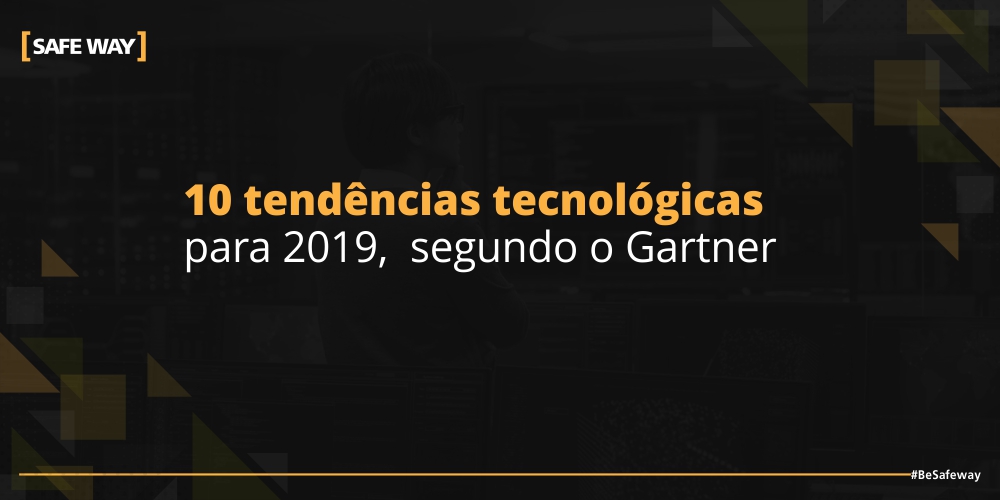October 16, 2018 - Copywriting - ItForum 360
Blockchain, augmented reality and quantum computing are some of the promises the market should keep an eye on.
O Gartner highlighted the key technology trends that organizations need to exploit in 2019. The consultancy defines a strategic technology trend as one that has disruptive potential and is starting to emerge from an emerging state for broader impact or use, or is growing rapidly. with a high degree of volatility and reaching inflection points over the next five years.
“Intelligence Digital Mesh has been a consistent theme for the past two years and continues to be a major driver until 2019. Trends in each of these three themes are a key ingredient in driving a continuous process of innovation as part of a ContinuousNEXT strategy,” said David Cearley, Gartner vice president.
“For example, artificial intelligence (AI) in the form of automated things and augmented intelligence is being used in conjunction with IoT and edge computing to deliver highly integrated intelligent spaces. This combined effect of multiple trends coming together to produce new opportunities and generate new disruptions is a hallmark of Gartner's top 10 strategic technology trends for 2019, ”he adds.
Meet the ten trends:
Standalone things
Autonomous things, such as robots, drones, and autonomous vehicles, use AI to automate functions previously performed by humans. Their automation goes beyond that provided by rigid programming models - they exploit AI to deliver advanced behaviors that interact more naturally with the environment and people.
“As autonomous things proliferate, we expect a shift from autonomous intelligent things to a swarm of collaborative intelligent things, with multiple devices working together, regardless of people or human contribution. For example, if a drone examined a large field and found it ready for harvesting, it could dispatch a 'standalone harvest'. Or in the delivery market, the most effective solution would be to use a standalone vehicle to map the target area. Robots and drones aboard the vehicle could guarantee the final delivery of the package, ”says the executive.
Augmented Analytics
Augmented Analytics (or augmented analytics) focuses on a specific area of augmented intelligence, using machine learning to transform how analytic content is developed, consumed and shared. Augmented analytics capabilities will quickly move to mainstream adoption as a key data preparation, data management, modern analytics, business process management, process mining, and data science platforms capability.
Automated augmented analytics insights will also be incorporated into enterprise applications — for example, HR, finance, sales, marketing, customer service, purchasing, and asset management — to optimize the decisions and actions of all employees within their context. , not just those of analysts and data scientists. Augmented analysis automates the process of data preparation, insight generation, and insight visualization, eliminating the need for professional data scientists in many situations.
“This will lead to citizen data science, an emerging set of features and practices that enable users whose primary task is outside the field of statistics and analysis to extract predictive and prescriptive insights from data. By 2020, the number of citizen data scientists will grow five times faster than the number of expert data scientists. Organizations can use citizen data scientists to bridge the data science and machine learning knowledge gap caused by the scarcity and high cost of data scientists, ”explains Cearley.
AI driven development
The market is rapidly shifting from an approach where professional data scientists must partner with application developers to create most AI-enhanced solutions to a model where the professional developer can operate alone using predefined models as a service. This provides the developer with an ecosystem of AI algorithms and models, as well as development tools tailored to integrate AI features and models into a solution.
Another level of opportunity for professional application development arises as AI is applied to the development process itself to automate various data science, application development, and testing functions. By 2022, at least 40% of the new application development projects will have AI co-developers on their team.
“Finally, highly advanced AI-based development environments, automating functional and non-functional aspects of applications, will usher in a new era of 'citizen application developer' where non-professionals can use AI-driven tools to generate new solutions. automatically. Tools that allow non-professionals to run applications without coding are not new, but we expect systems with AI technology to offer a new level of flexibility, ”said Cearley.
Digital twins
A digital twin is a digital representation of a real world entity or system. By 2020, Gartner estimates that there will be over 20 billion sensors connected and terminals and digital twins will exist for potentially billions of things. Organizations will deploy digital twins and evolve over time, improving their ability to collect and visualize the right data, apply analytics and rules, and effectively respond to business objectives.
“One aspect of the evolution of digital twins that goes beyond IoT will be ventures implementing their organization's digital twins (DTOs). A DTO is a dynamic software model that relies on operational or other data to understand how an organization operationalizes its business model, connects with its current state, implements resources, and responds to changes to deliver expected value to the customer. DTOs help drive business process efficiency and create more flexible, dynamic and responsive processes that can react to changing conditions automatically, ”says the executive.
Enhanced Edge
Edge refers to endpoint devices used by people or embedded. Edge computing describes a computing topology in which information processing and content collection and delivery are brought closer to these endpoints. It attempts to maintain local traffic and processing to reduce traffic and latency.
In the short term, the edge is being driven by IoT and the need to keep processing near the end rather than on a centralized cloud server. However, instead of creating a new architecture, cloud computing and edge computing will evolve as complementary models, with cloud services being managed as a centralized service running not only on centralized servers, but on-premise and distributed servers. own edge devices.
Over the next five years, specialized AI chips, plus increased processing power, storage and other advanced features, will be added to a wide range of edge devices. The extreme heterogeneity of this world of integrated IoT and the long lifecycles of assets such as industrial systems will create significant management challenges. As 5G matures, the expanding edge computing environment will have more robust communication for centralized services. 5G provides lower latency, higher bandwidth and a dramatic increase in the number of nodes (edge endoints) per km2.
Immersive experience
Conversation platforms are changing the way people interact with the digital world. Virtual reality (VR), augmented reality (AR) and mixed reality (MR) are changing the way people perceive the digital world. This combined change in perception and interaction models leads to the immersive user experience in the future.
“Over time, we will move from thinking about individual devices and fragmented user interface (UI) technologies to a multichannel and multimodal experience. The multimodal experience will connect people with the digital world on hundreds of peripheral devices that surround them, including traditional computing devices, wearables, automobiles, environmental sensors and consumer devices, ”said Cearley. “The multichannel experience will use all human senses as well as advanced computer senses (such as heat, humidity and radar) in these multimodal devices. This multi-experience environment will create an environment experience in which the spaces around us define 'computer' rather than individual devices. In fact, the environment is the computer. ”
Blockchain
Blockchain promises to reshape industries, bringing confidence, providing transparency and reducing friction between business ecosystems, potentially reducing costs, shortening transaction settlement times and improving cash flow. Today, trust is placed in banks, clearing houses, governments, and many other institutions as central authorities with the "one version of the truth" held securely in their databases. The centralized trust model adds delays and friction costs (commissions, fees and the value of money) to transactions. The blockchain concept provides an alternative trust mode and eliminates the need for central authorities in transaction arbitration.
Today's blockchain technologies and concepts are immature, misunderstood and unproven in mission-critical business operations. This is particularly true with complex elements that support more sophisticated scenarios. "Despite the challenges, the significant potential for disruption means that CIOs and IT leaders should start evaluating blockchain even if they do not aggressively adopt technologies in the coming years," he warns.
Many blockchain initiatives today do not implement all the attributes of the tool - for example, a highly distributed database. These blockchain-inspired solutions are positioned as a means of achieving operational efficiency by automating business processes or digitizing records. They have the potential to enhance information sharing between known entities as well as improve opportunities for tracking physical and digital assets.
However, these approaches lose the value of the actual blockchain interruption and can increase vendor lock-in. Organizations choosing this option must understand the limitations and be prepared to move to complete blockchain solutions over time and that the same results can be achieved through the most efficient and tailored use of existing unblocked technologies.
Smart spaces
An intelligent space is a physical or digital environment in which humans and technology-based systems interact in increasingly open, connected, coordinated, and intelligent ecosystems. Multiple elements - including people, processes, services and things - come together in one smart space to create a more immersive, interactive and automated experience for a targeted set of people and industry scenarios.
“This trend has been gathering for some time around elements such as smart cities, digital workplaces, smart homes and connected factories. We believe the market is entering a period of accelerated delivery of robust smart spaces, with technology becoming an integral part of our daily lives, whether as employees, customers, consumers, community members or citizens, ”said Cearley.
Ethics and digital privacy
Digital ethics and privacy are growing concerns for individuals, organizations and governments. People are increasingly concerned about how their personal information is being used by organizations in the public and private sectors, and the reaction will only grow for organizations that are not proactively addressing these concerns.
“Any discussion of privacy must be grounded in the broader topic of digital ethics and the trust of its customers, constituents and employees. While privacy and security are key components in building trust, trust is actually more than just those components. Trust is the acceptance of the truth of a statement without evidence or investigation. Ultimately, an organization's position on privacy must be driven by its broader position on ethics and trust. Switching from privacy to ethics leads the conversation beyond 'we are in compliance' towards 'we are doing the right thing'.
Quantum computing
Quantum computing is a type of non-classical computing that operates in the quantum state of subatomic particles (eg, electrons and ions) that represent information as elements denoted as quantum bits (qubits). The parallel execution and exponential scalability of quantum computers means that they stand out from too complex problems for a traditional approach or where traditional algorithms would take a long time to find a solution.
Industries such as the automotive, financial, insurance, pharmaceutical, military, and research organizations have the most to gain from advances in quantum computing. In the pharmaceutical industry, for example, the technology could be used to model molecular interactions at atomic levels to accelerate the time to market for new cancer drugs, or it could more accurately accelerate and predict protein interaction leading to new pharmaceutical methodologies.
About [SAFEWAY]
THE [SAFEWAY] is a widely recognized company as a provider of premium information security and cybersecurity solutions. From its extensive portfolio, we highlight several solutions, including those based on platforms:
- Archer da RSA Security, considered by the institutes Gartnerand Forrester and by the market itself, the most complete process integration solution for Governance, Risk Management, Compliance and Business Continuity Management;
- [SAFEWAY]Security Tower, supported by IBM Qradar (Watson technology), tailored to each organization in its security and cyber defense management needs.
- And others, involving technologies Imperva, Thales, BeyondTrust, Manly, WatchGuard Technologies




